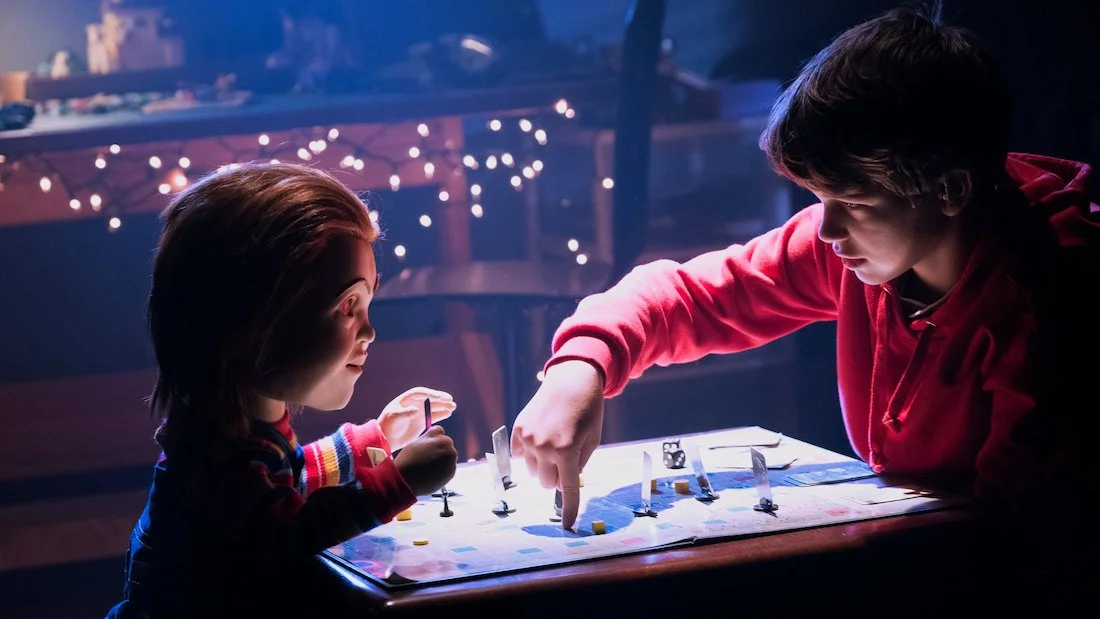CHILD’S PLAY (2019)
In 2019, the studio that started the franchise 31 years prior regained the rights to the iconic killer doll franchise, CHILD’S PLAY. I will admit, the release of a new Chucky by the original studio seemed unnecessary and wrong-headed, especially when series mastermind Don Mancini had been churning out direct-to-video releases. While I still have issues with this strategy, I have definitely warmed on the feature itself. The 2019 version of the franchise makes some obvious and necessary changes to the formula from the first movie. Some of them work, while others at times feel forced, but it feels clear that the new vision for the motion picture franchise, at least from the filmmaker’s perspective, is an upgrade. It isn’t always successful but not just making a tired redo of the original picture is definitely a wise move on their part. It gives the motion picture a reason to exist, and doesn’t make it feel as much of a craven cash grab by greedy studio executives.
When Chucky first arrived on the scene in 1988 he was simply a doll that could speak. In 2019, however, the multinational company responsible for his creation, Kaslan Corporation, has made many upgrades to their model. The movie cleverly opens with a commercial starring Tim Matheson (of ANIMAL HOUSE fame) playing the founder of the Kaslan Corporation. Henry Kaslan. In a nod to Mancini’s original inspiration for the demented doll, My Buddy, this version of Chucky is a Buddi doll. In keeping with the times, Chucky can do more than simply speak. Thanks to modern inventions like the cloud, he can also get online through the internet and almost act as an Alexa for the modern home. Another noticeable change between the two movies is the actor voicing Chucky. Gone is Brad Dourif’s iconic voice, replaced by the equally impressive work of Mark Hamill, who may be best known as a Skywalker from a galaxy far, far away—but he has also made a prosperous career for himself as a voice actor, most famously voicing Joker for WB animation.
Another major difference between the two Chuckys is how they came to be. In the version imagined by Don Mancini, Chucky came into being as the reincarnated version of a serial killer. In 2019, however, his creation is much more mundane. He is simply the by-product of some product sabotage. Our new Chucky comes to life in a toy plant in Vietnam where the Buddi dolls are manufactured. A disgruntled labourer, after being read the riot act by his dissatisfied employer for what he perceives as poor work, forgoes the mandatory safety updates for the doll.
Chucky ends up the property of the Barclays in a different manner than the original, but in an organic way that, while not necessarily a sign of the times, does have an air of believability. Instead of being purchased on the cheap from a homeless man, this particular Buddi doll is a defective return. Rather than paying for the doll, Andy’s mother first asks her boss if she can simply have the doll, since it was labelled for the scrap heap, according to his own admission. Karen’s boss Wes, once again a stickler for the rules, refuses to just let the doll go. However, when Karen lets slip her knowledge that he was sleeping with a co-worker on company property, he reluctantly agrees for fear of his secret being exposed.
Much like the change in abilities for a modern Chucky, the 2019 movie has a more diverse cast, including Bryan Tyree Henry, replacing Chris Sarandon, and acquitting himself admirably as Detective Mike Norris, whose mother Doreen lives in Karen and Andy’s building in this new update. Also, where Karen was played as Andy’s chaste maternal widow by Catherine Hicks in the original, 2019’s version plays to Aubrey Plaza’s sarcastic strengths. She is given a love interest, named Shane who is constantly at odds with Andy. Shane is played by David James Lewis with just the right amount of dickhead charm to make Karen’s interest sincere—and her son’s disdain for him genuine. One obvious thing both Karens share is an unwavering love of their sons, Andy. 2019’s version is played with less wide-eyed wonder than what Alex Vincent brought to the original version. Gabriel Bateman’s Andy is 13 and he is less prone to be amazed by everything, which feels very relatable. As someone who is slow to make friends, the character felt especially honest in its depiction of the adolescent.
As well as the technological upgrades to Chucky along with his means of creation, this new Chucky has to have a reason for doing harm. The 1988 version kills to take revenge on his enemies, this new Chucky has no un-revenged spirit guiding him. Instead, it’s a fierce protectiveness of his human that the doll that leads to its many acts of violence. More than once the doll excuses his actions by claiming the victims were hurting Andy, or intending to divide Andy and Chucky. This is initially illustrated early on. After the family cat scratches Andy, Chucky attacks it, with the young boy finding his doll strangling the pet. Seeing that his human charge is angry with him, Chucky relents but is confused by this reaction. Andy tries to explain that what Chucky was doing was more than an overreaction, but because of his altered programming, this becomes a lesson Chucky refuses to learn. Chucky only gets worse from there.
CHILD’S PLAY 2019 is a worthy while reboot of the beloved franchise began in 1988. It is a film that wisely differentiates itself enough to justify its creation—a remake done the right way, while still honouring the original movie’s spirit.




